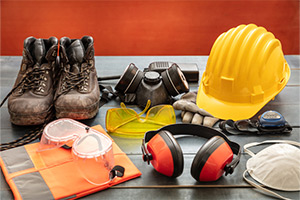Creating and promoting a safe working environment for employees should be a top priority for business owners. Not only does it protect their well-being, and mitigates the risk of workplace accidents and injuries, ultimately helping you avoid costly workers’ comp claims. By implementing effective safety measures and providing thorough training, you can promote a culture of safety within your organization. Our tips teach you how to enhance workplace safety and safeguard your business from potential risks.
Complying With OSHA Rules
Prioritizing a safe work environment is the right thing to do and a legal requirement outlined by OSHA. The Occupational Safety and Health Administration (OSHA) is a federal agency within the Department of Labor. Its goal is to establish clear and precise safety rules and ensure all workplaces remain safe and accident-free. Failing to comply with these regulations can lead to severe consequences, including fines and legal issues. If you are uncertain about the safety standards of your workplace, request a free on-site consultation from OSHA to resolve any possible safety issues.
7 Simple Steps For a Safer Workplace
Employee safety should always be a top concern, no matter your industry. Here are seven ways you can improve workplace safety.
1. Wear Proper Uniforms and Protective Gear

Proper uniform and protective gear play a vital role in ensuring workplace safety. It serves as the first line of defense against hazards, such as physical injuries, chemical exposure, extreme temperatures, and other occupational risks. Additionally, uniforms can provide visibility and identification, especially in a busy work environment. By prioritizing proper uniforms and protective gear, you can demonstrate your commitment to your employee’s well-being and create a safer work environment for everyone.
2. Keep Things Clean
A clutter-free and well-organized workplace reduces the risk of slips, falls, and trips. To ensure workplace safety, business owners should implement regular cleaning schedules, provide proper storage solutions, and encourage employees to keep their workstations tidy. Conducting routine inspections and addressing potential hazards will contribute to a safer environment and minimize the risk of workplace injuries.
3. Accident-Proofing Your Environment
Taking proactive measures to accident-proof your building can significantly reduce the risk of accidents and promote a safe workplace. While the specific actions will depend on your industry and work environment, there are several steps you can take. Consider installing lighted walkways and ensuring proper signage for a clear pathway, implementing handrails and non-slip flooring in areas prone to slip and falls, and prioritizing ventilation and adequate lighting to enhance visibility. Additionally, ergonomic workstations should be provided to reduce the risk of repetitive strain injuries.
4. Use Labels and Signs

Clear and visible signage helps employees easily identify potential hazards, emergency exits, and rules. They are a cheap and functional way to communicate important information. Remember that signs are only effective if they are clear, concise, easy to understand, and placed strategically where they will be noticed. Regularly inspect and replace signs immediately if damaged or outdated.5.
5. Designate Emergency Exits
Whenever you board a plane, you’re shown the emergency exit doors and procedures before taking off. This crucial practice ensures everyone knows where to find the nearest exit and what to do in an emergency. Similarly, conducting fire drills and other exercises in the workplace can help remind employees of the closest exit and emergency procedures. Make sure to maintain clear pathways to exits, have readily accessible first aid kits, fire extinguishers, and defibrillators, and that employees know how to work them.
6. Perform Regular Equipment Inspections
Implementing regular equipment checks, cleaning, and maintenance are essential to prevent injuries and maintain a safe working environment. By performing routine inspections, you can proactively identify and address potential hazards or malfunctions in your equipment before they lead to accidents. These regular checks ensure that your machinery and tools are in optimal working condition and minimize production delays. It’s equally important to log all accidents and equipment failures for ongoing reporting and help detect future equipment issues.
7. Keep an Open Dialogue About Safety

Encourage your team to share their opinions, report any hazards they encounter, and provide feedback on the effectiveness of existing safety measures and protocols. While fostering a culture of safety is important, employees who do not follow proper protocols must be addressed. Offer them the opportunity to comply and follow procedures, but if they fail to do so, it may be necessary to take appropriate disciplinary action. Remember, workplace safety is the responsibility of both individual workers and the workforce as a whole.
Protect Yourself and Your Employees With Workers’ Comp
Accidents can happen in any workplace, regardless of how careful you strive to be. Unfortunately, these accidents can result in injuries, illnesses, and even fatalities, leading to potential financial and legal consequences. That’s why having Workers’ Compensation Insurance is crucial in protecting you and your workers. Speak with one of our Commercial Insurance Specialists today at (866) 570-7335 for a quick and easy workers’ compensation quote and ensure you have the necessary coverage to support your employees and safeguard your business.
The information in this article is obtained from various sources and offered for educational purposes only. Furthermore, it should not replace the advice of a qualified professional. The definitions, terms, and coverage in a given policy may differ from those suggested here. No warranty or appropriateness for a specific purpose is expressed or implied.


